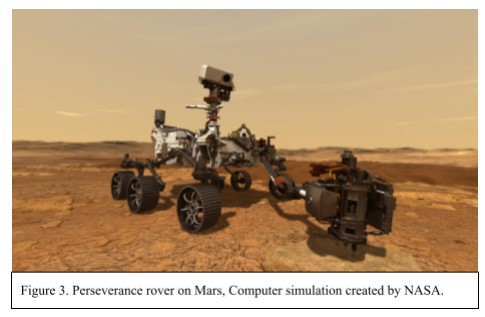How Anabaena can improve plant growth on Mars by acting as a biofertilizer
DOI:
https://doi.org/10.58445/rars.61Keywords:
Mars, Biofertilizer, Cyanobacteria, Anabaena, Martian colonization, NASA, Nitrogen fixation, Soil, sustainabilityAbstract
The human race has the need to explore and colonize as seen throughout history. Humanity has conquered land, sea, and sky. It's time for humanity's greatest mission to the next frontier as we plan to colonize Mars and make it a second home. Companies such as SpaceX, Blue Origin, and governmental agencies such as NASA are planning to conduct missions to colonize Mars by 2030. However, the colonization process is very difficult, expensive, and time consuming. The Martian surface is barren, cold, and dry making it impossible to grow crops on the surface (Gonçalves, 2021). Early Martian colonies will be completely reliant off of Earth for their resources. However, transport of goods from Earth to Mars takes about 7 months, this is a very costly endeavor, and can only be done every twenty six months when Earth and Mars are closest. For Mars to become a sufficient self sustaining colony there needs to be a way for the colonizers to make their own food. Martian soil is similar to Earth’s consisting of nitrogen, potassium, and phosphorus but the concentrations are too low to support any plant growth. Thus, Martian colonists must grow crops in controlled greenhouses. To help increase the nitrogen content in low nutrient Martian soil, cyanobacteria could be used to help. Cyanobacteria are ubiquitous photosynthetic microorganisms that can live in strenuous environments. Cyanobacteria, especially members of the genus Anabaena, are known to fix nitrogen, the process of converting atmospheric nitrogen into biologically available forms. If cyanobacteria are introduced into martian colonies for agricultural purposes, nutrient levels in soil could increase thus increasing crop yields on the planet. To test whether cyanobacteria can improve plant growth and increase nitrogen content in soil.
References
Behrens, C. B. (2021, December 12). Solar Power is Never Going to Work on Mars, and Everybody Knows It. Medium. Retrieved September 7, 2022, from https://medium.com/swlh/solar-power-is-never-going-to-work-on-mars-and-everybody-knows-it-b2fb221722b1#:%7E:text=There’s%20a%20history%20of%20using,for%20a%20number%20of%20reasons.
The Fact and Fiction of Martian Dust Storms. (n.d.). NASA. Retrieved September 7, 2022, from https://www.nasa.gov/feature/goddard/the-fact-and-fiction-of-martian-dust-storms/
Gronstal, A. (n.d.). NASA Astrobiology. Retrieved September 7, 2022, from https://astrobiology.nasa.gov/news/life-at-low-pressure-planetary-protection-and-the-habitability-of-mars/#:%7E:text=Low%20Pressure%20on%20Earth&text=%E2%80%9CLow%2Dpressure%20tolerant%20bacteria%20are,of%20Earth’s%20sea%20level%20pressure.%E2%80%9D
Harvesting Mars | Science Mission Directorate. (n.d.). Retrieved September 7, 2022, from Harvesting Mars | Science Mission Directorate
NASA Confirms Evidence That Liquid Water Flows on Today’s Mars. (n.d.). NASA. Retrieved September 7, 2022, from https://www.nasa.gov/press-release/nasa-confirms-evidence-that-liquid-water-flows-on-today-s-mars/
Poston, D., & McClure, P. (2018, January 18). How a Small Nuclear Reactor Could Power a Colony on Mars or Beyond (Op-Ed). Space.com. Retrieved September 7, 2022, from https://www.space.com/39413-small-nuclear-reactor-kilopower-mars-colony.html
Ross, H. (2021, April 22). Atmospheric Pressure and the Possibility of Life. Reasons to Believe. Retrieved September 7, 2022, from https://reasons.org/explore/blogs/todays-new-reason-to-believe/atmospheric-pressure-and-the-possibility-of-life
Williams, M. (2016, November 21). How bad is the radiation on Mars? Retrieved September 7, 2022, from https://phys.org/news/2016-11-bad-mars.html#:%7E:text=Over%20the%20course%20of%20about,(8%20rads)%20per%20year.
Torchinsky, R. (2022, March 17). Elon Musk hints at a crewed mission to Mars in 2029. NPR.org. Retrieved September 18, 2022, from https://www.npr.org/2022/03/17/1087167893/elon-musk-mars-2029
ICON 3D Prints the First Simulated Mars Surface Habitat for NASA Designed by Renowned Architecture Firm BIG-Bjarke Ingels Group | ICON. (n.d.). Retrieved September 18, 2022, from https://www.iconbuild.com/updates/icon-3d-prints-the-first-simulated-mars-surface-habitat-for-nasa/
Kooser, A. (2021, September 15). Mars explorers might make concrete-like materials from their own blood and urine. CNET. Retrieved September 18, 2022, from https://www.cnet.com/science/mars-explorers-might-make-concrete-like-materials-from-their-own-blood-and-urine/#:%7E:text=A%20study%20published%20in%20the,as%20stron g%20as%20regular%20concrete.
Mars polar cap mystery solved. (n.d.). Retrieved September 18, 2022, from https://www.esa.int/Science_Exploration/Space_Science/Mars_Express/Mars_polar_cap_mystery_solved
Gonçalves, A. L. (n.d.). The Use of Microalgae and Cyanobacteria in the Improvement of Agricultural Practices: A Review on Their Bio Fertilising , Biostimulating and Biopesticide Roles. MDPI. Retrieved October 20, 2022, from
https://www.mdpi.com/2076-3417/11/2/871/htm
NCBI - WWW Error Blocked Diagnostic. (n.d.). Retrieved October 20, 2022, from https://www.ncbi.nlm.nih.gov/pmc/articles/PMC94895/
Billi, D. (n.d.). Exploiting a perchlorate-tolerant desert cyanobacterium to support bacterial growth for in situ resource utilization on Mars | International Journal of Astrobiology. Cambridge Core. Retrieved October 20, 2022, from https://www.cambridge.org/core/journals/international-journal-of-astrobiology/article/exploiting-a-perchloratetolerant-desert-cyanobacterium-to-support-bacterial-growth-for-in-situ-r esource-utilization-on-mars/35295D8E25D769B1580CEE541EB776F4
ESA - Robotic Exploration of Mars - Comparing the atmospheres of Mars and Earth. (n.d.). Retrieved October 20, 2022, from https://exploration.esa.int/web/mars/-/60153-comparing-the-atmospheres-of-mars-and-earth
Roberts, A. D., Whittall, D. R., Breitling, R., Takano, E., Blaker, J. J., Hay, S., & Scrutton, N. S. (2021, September 10). Blood, sweat, and tears: Extraterrestrial regolith biocomposites with in vivo binders. Materials Today Bio. Retrieved October 20, 2022, from https://www.sciencedirect.com/science/article/pii/S2590006421000442
Chittora, D., Meena, M., Barupal, T., Swapnil, P., & Sharma, K. (2020, February 13). Cyanobacteria as a source of biofertilizers for Sustainable Agriculture. Biochemistry and Biophysics Reports. Retrieved October 20, 2022, from https://www.sciencedirect.com/science/article/pii/S2405580819303449#:~:text=Cyanobacteria%20are%20used%20in%20ecofriendly,biomass%20of%20very%20high%20value.&text=Cyanobacteria%20have%20an%20emerged%20potential,are%20economical%20an d%20environment%20friendly.
Zehr, J. P. (2011, January 10). Nitrogen fixation by Marine Cyanobacteria. Trends in Microbiology. Retrieved October 20, 2022, from https://www.sciencedirect.com/science/article/abs/pii/S0966842X10002155
MCKAY, C. (n.d.). (PDF) The Physics, Biology, and environmental ethics of making Mars... Retrieved October 20, 2022, from https://www.researchgate.net/publication/11020305_The_Physics_Biology_and_Environmental_Ethics_of_Making_Mars_Habitable
Mapstone, L. J., Leite, M. N., Purton, S., Crawford, I. A., & Dartnell, L. (2022, March 19). Cyanobacteria and microalgae in supporting human habitation on Mars. Biotechnology Advances. Retrieved October 20, 2022, from https://www.sciencedirect.com/science/article/pii/S0734975022000428?via%3Dihub
NASA. (2014, June 3). NASA Mars Exploration. NASA. Retrieved October 21, 2022, from https://mars.nasa.gov/
Cowart, A. (2021, February 3). Jezero crater. Flickr. Retrieved October 21, 2022, from https://www.flickr.com/photos/132160802@N06/50905666446
staff, S. X. (2019, June 17). Dust storms on Mars. Phys.org. Retrieved October 21, 2022, from https://phys.org/news/2019-06-storms-mars.html
Icon 3D prints the first simulated Mars surface habitat for NASA designed by renowned architecture firm Big-Bjarke Ingels Group. ICON. (2021). Retrieved October 21, 2022, fromhttps://www.iconbuild.com/updates/icon-3d-prints-the-first-simulated-mars-surface-ha bitat-for-nasa
McClure, P., & Poston, D. (2018, January 18). How a small nuclear reactor could power a colony on Mars or beyond (op-ed). Space.com. Retrieved October 21, 2022, from https://www.space.com/39413-small-nuclear-reactor-kilopower-mars-colony.html
Space Technology. (2022, March 3). Nuclear power in space. The Space Techie. Retrieved October 21, 2022, from https://www.thespacetechie.com/nuclear-power-in-space/
Cyanobacteria. Smithsonian Ocean. (2019, April 29). Retrieved October 21, 2022, from https://ocean.si.edu/ocean-life/cyanobacteria#:~:text=This%20blue%2Dgreen%20microbe%20called,cyanobacteria%20and%20other%20photosynthetic%20organisms

Downloads
Posted
Versions
- 2022-12-24 (4)
- 2022-12-24 (3)
- 2022-12-24 (2)
- 2022-11-15 (1)
Categories
License
Copyright (c) 2022 Ophelia Burden

This work is licensed under a Creative Commons Attribution-NonCommercial-NoDerivatives 4.0 International License.

